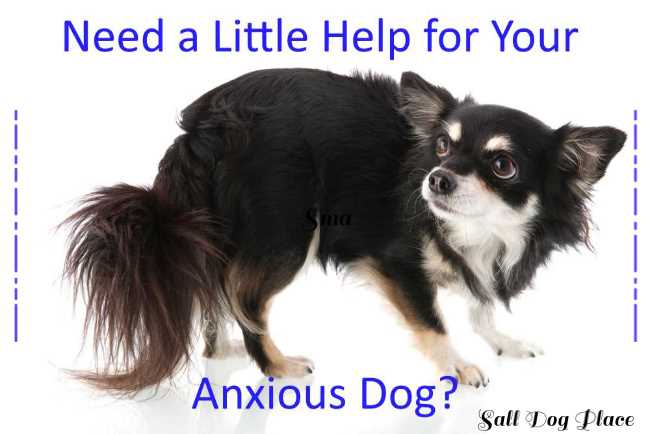- Small Dog Place Home
- Emotional Problems
- General Anxiety in Dogs
General Anxiety in Dogs: Help For your Nervous Pup
General Anxiety in Dogs by Janice Jones, Updated 03-24-2024
We all know about how anxiety can affect people, but did you know that this same disorder is more common in dogs that were once known?
The Department of Health and Human Services report five major types of anxiety disorders in people according to.
 General Anxiety in Dogs
General Anxiety in DogsGeneralized Anxiety Disorder or GAD
This a condition where a person (or dog) shows chronic anxiety, worry, or tension even with there is little or nothing that could cause the reaction. Chronic separation anxiety is an example and occurs in some dogs when they cannot be close to their human.
Obsessive-Compulsive Disorder or OCD
Obsessive-compulsive Disorder or OCD occurs when unwanted thoughts (obsessions) or repetitive behaviors (compulsions) interfere with day to day living. Dogs that exhibit repetitive behaviors such as tail chasing, spinning, or sucking on their skin may be diagnosed as OCD.
Panic Disorder
A panic attack is a strong fear that accompanies physical symptoms such as heart palpitations, dizziness, shortness of breath, and even chest pain. The disorder is diagnosed when a person continues to have these attacks repeatedly. Fireworks, gunshots or severe thunderstorms can often provoke a panic attack in a dog.
Post-Traumatic Stress Disorder
Post-Traumatic Stress Disorder (PTSD) is a condition that occurs after exposure to a terrifying event where physical harm occurred or was threatened. A good example of this type of anxiety disorder can be found in military dogs or those used in K-9 Units of law enforcement.
Social Phobia
Social Phobia is a disorder occurring in everyday social situations. Dogs that suffer from social anxiety will become fearful of people and may respond by hiding, backing away, or reacting aggressively.
Fear and Anxiety
 General Anxiety in Dogs
General Anxiety in DogsFear and anxiety are natural reactions to some form of stress, and these emotions are our way of saving ourselves in a life-threatening emergency. If our ancestors did not experience fear when they encountered a saber-toothed tiger, we might not be around today to read this article.
The fight or flight reaction is the way our bodies respond to a stressful situation, and it is present in many other species. You’ve no doubt experienced this yourself.
Fear will stimulate our sympathetic nervous system, which will increase adrenaline and noradrenaline secretions, increase blood pressure, and heart rate. Blood cortisol levels rise and prepare our bodies for a quick response.
General Anxiety in Dogs (Generalized Anxiety Disorder)
If this reaction occurs too frequently, both our dogs and ourselves suffer the negative consequences of a body and mind that is always on high alert. In dogs, severe behavioral problems can develop such as separation anxiety, panic, noise sensitivity (fear of thunderstorms) and avoidance reactions.
Any behavior that seems to get in the way of healthy living should be of concern. Not only do dogs show behavioral signs, but some physical symptoms such as excess shedding, changes in eating and sleep patterns, or an inability to just relax can occur.
If your dog acts nervous and shows some symptoms of anxiety regularly, he may be suffering from a generalized anxiety disorder.
You will know that your dog is anxious if he is always on the lookout, always on edge, and never able to let their guard down. It is often difficult to determine what is causing a nervous reaction.
Dr. Meghan Herron, head of the behavioral medicine clinic at Ohio State University Veterinary Medical Center identifies several common signs of an anxious dog. These signs can include:
- Panting
- Pacing
- Whining or whimpering
- Avoidance of eye contact
- Fidgeting
- Attempts to move towards the exit or away from the feared object
- Hiding
- Trembling
- Displacement behaviors such as yawning, lip licking, air sniffing, wet-dog shaking, and shutting down and avoiding interactions.
- Spontaneous peeing or pooping
- Exhibiting destructive behavior
- Tucking their Tail
- Their pupils are dilated
- Avoiding interactions
A Typical Case of General Anxiety in Dogs
Lucy is a five-year-old Shih Tzu who lives in a breeding household. She loves being a mother and looks forward to whelping a litter of puppies. She’s a phenomenal mother and spends countless hours caring for, rearing and training her puppies.
Unfortunately, fear and anxiety make her job awkward and uncomfortable. She’s watched her pups disappear over the years, to new puppy owners but the stress of pregnancy, nursing, and rearing puppies has taken a toll on her body. She’s lost her hair and now finds it hard to manage her stress when new people visit.
Even friendly people cause stress and the never-ending visits to the veterinarian for health testing are just too much to endure. Despite the attempts of the breeder to provide a stress-free environment, Lucy can’t cope with her ever-changing environment.
She’s been spayed and retired, but the thought of finding a loving forever home for Lucy seem elusive. Lucy’s symptoms include fear of visitors even friendly humans.
Peeing and Pooping when confronted with a new person or dog and a vigilant that also contains signs of aggressiveness and fearfulness (growling, barking, and hiding behind sofas or beds.) She’s all but hairless, her hair loss presumably due to stress.
 The face of General Anxiety in Dogs
The face of General Anxiety in DogsCauses of General Anxiety in Dogs
It is easy to blame something or someone on our dog’s anxiety, but teasing out the main culprit may be more complicated than it looks initially.
Physical illness, especially those chronic in nature, can have a toll on anyone, including dogs. Physical and mental abuse is another prominent factor that will have lasting effects on dogs, long after the damage is gone.
Each dog is an individual and like humans have different levels of tolerance for stressful situations. Some dogs, according to Herron, will have difficult from the early days, focusing, learning basic commands and have difficulty filtering out potentially anxiety-provoking stimuli that might occur during group training sessions.
Not all dogs are adaptable to all situation, and some have real problems when changes occur in their little environment. Even the smallest change can cause stress.
Moving, the addition of new family members, removal of other pets, or the addition of new pets can also lead to general anxiety in dogs. Even something as simple as changes in food, dishes, toys, and bedding can upset some dogs.
Changes in schedules that arise as humans take on new jobs may also cause stress. New people moving into or out of the home can be very stressful to some dogs. Any type of stress can trigger a generalized anxiety disorder in susceptible dogs.
Role of Genetics
Genetics plays a role in the primary cause of fear and anxiety in dogs.
It’s not surprising that small breed dogs were more anxious than larger breeds.
High on the list of all five dimensions included chihuahuas, dachshunds, Maltese, toy poodles, and Yorkshire Terriers. The Beagle and Shih Tzu were close behind scoring high on four of five dimensions.
Treating General Anxiety in Dogs
To treat anxiety, you first must identify the triggers that set off the anxiety or fear response.
Behavioral Modification Through Desensitization
Desensitization has been helpful in both human and dog treatments and works by changing your dog’s response to the trigger that causes an anxious reaction by pairing low-intensity anxiety with something happy such as a treat or a favorite activity. This is often something that can be done under the supervision of a dog behavioral specialist.
If you have a nervous dog, relax, there is help and treatment can make a tremendous difference in the quality of life for your furbaby. Your ability to calm yourself will also help your dog. Unfortunately, you can't stop there.
As of this writing, behavior modification combined with other methods seems to be the best options for a successful outcome.
There are also a variety of products on the market that can help with anxiety, and we will look at each one individually.
Prescription Medications
Some types of antidepressants and antianxiety medications used in people are also useful in dogs, mainly if used in conjunction with behavior modification.
Your vet may decide that a prescription drug would help your anxious dog. Often they will prescribe antidepressants or antianxiety medication. Alprazolam (Xanax), or Amitriptyline (Elavil) a tricyclic antidepressant, are both common choices for dogs with an anxiety disorder.
Clomicalm, an antidepressant drug, is used in dogs to treat behavior problems such as separation anxiety, excessive barking, and destructive behavior.
The choice will be made by the veterinarian based on your dog’s current health, allergies, medical history, and several other factors. Never use another pet’s medication for your dog even if they’re in the same household.
Over-the-Counter Medications for General Anxiety in Dogs
Often, veterinarians will recommend over the counter medications such as Benadryl. This antihistamine can serve as a mild sedative, especially during a time when anxiety is likely to occur, such as during fireworks or thunderstorms.
Small Dog Place always recommends that you consult your veterinarian before giving any over the counter medications. Too much medicine can harm your dog, so it is essential to follow the directions of your vet.
Hemp-Based Products Useful for General Anxiety in Dogs
Many pet owners are switching to hemp products or pet safe cannabis oils for their dog’s anxiety problems. People are beginning to find alternatives to the pharmaceutical industry for a wide variety of reasons, some of which are the harsh side effects and cost of prescription drugs.
People with chronic pain, anxiety, inflammation, depression, and many other ailments are moving towards treatment with CBD oil. It’s no surprise that this same substance that can relieve many symptoms of people can also help our pets.
Hemp products use plant extracts and other organic ingredients that do not provide the “high.” but offer the other medicinal properties that can help with a wide variety of different medical conditions, including anxiety.
Not all hemp-based products are created equally, so it is vital that you check out each product's claims online.
Giving this product in the correct dosage is also critical if you want to achieve the benefits that they can provide. You should find out how much CBD oil you should give your dog.
Your veterinarian may prefer to restrain from discussing cannabis extracts for your dogs because it is relatively new and many traditional vets do not use alternative treatments in their practices.
Studies involving the use of medical marijuana to treat arthritis and seizure disorders in pets are currently underway at Colorado State University. The results may help facilitate the recognition of cannabis extracts as a useful medicinal tool for pets.
Herbal Remedies May Help With General Anxiety in Dogs
Just like people who prefer a more natural remedy, dogs can benefit from the same substances. Echinacea and Valerian Root may be helpful for your dog, but before starting a new treatment regime, check with your vet or a homeopathic vet for recommendations.
Bach Flower essences, melatonin, theanine, tryptophan, and various herbal combinations can also be highly helpful in reducing anxiety. There are many of these on the market today, but Bach’s Rescue Remedy Pet and Rx Vitamins for Pets’ Nutricalm are my favorite herbal treatments for reducing stress and creating a sense of calm.
Aromatherapy
Just like people, aromatherapy can help dogs reduce anxiety and provide a sense of calm that can be achieved by some essential oils.
Applying essential oils to your dog’s paws, spraying the scent to their bedding or adding the oil to a diffuser can calm and produce an environment of restfulness and serenity.
The essential oil, lavender may create a sense of calm and sedate both people and dogs. This scent can help you feel sleepy and help you sleep.
Chamomile provides a calming effect. Sweet Marjoram has been helpful with stress relief with pets.
Compression Clothing May Help in Some Cases of General Anxiety in Dogs
These garments for dogs function like a baby’s swaddling blanket and have an anxiety-reducing effect. The Thundershirt is the most popular compression shirt available but not the only one on the market today.
This type of shirt can reduce anxiety from thunderstorms and fireworks by applying a gentle, constant pressure around the torso. “It’s believed that this pressure releases oxytocin, a calming hormone.” States CEO and founder Phil Blizzard.
Pheromones: Collars and Diffusers
Pheromones are hormone-like chemicals that create signals that dogs pick up and can influence behavior. Products like DAP (Dog Appeasing Pheromone) can help calm an anxious dog.
These products can be used as a collar diffuser or a spray. They have been quite beneficial for dogs who do not take readily to oral products. DAP Dog Appeasing Pheromone is also helpful to a dog with sound sensitivity.
Takeaway from General Anxiety in Dogs
Researchers continue to identify issues in dogs that mimic the same problems that occur in people. Generalized Anxiety Disorder (GAD) is one of those psychological problems that plague our four-legged friends in similar ways that we experience as humans.
Constant fear and nervousness are the hallmarks of this anxiety disorder, and those symptoms put dogs on continuous alert, creating a hypervigilant approach to life that leaves lasting psychological symptoms in our dogs.
To help our anxious dogs, we need to first identify the problem and then seek help form, knowledgeable professionals. A variety of treatments are at our fingertips.
From traditional medicine, we can use anti-anxiety or antidepressant medications to help our fur babies. If we prefer a more holistic natural treatment, there are a wide variety of remedies from which to choose.
Natural holistic medicines can include hemp products, aromatherapy, pheromones, herbal products, and compression products, all designed to help our anxious dog.
References Used (General Anxiety in Dogs)
Overall, Karen L. (2013). Manual of Clinical Behavioral Medicine for Dogs and Cats. (pp 235-238). Elsevier
Serpell J.A., Duffy D.L. (2014) Dog Breeds and Their Behavior. In: Horowitz A. (eds) Domestic Dog Cognition and Behavior. Springer, Berlin, Heidelberg
About Janice (author and voice behind this site)
Janice Jones has lived with dogs and cats for most of her life and worked as a veterinary technician for over a decade. She has also been a small-breed dog breeder and rescue advocate and holds academic training in psychology, biology, nursing, and mental health counseling. Her work focuses on helping dog owners make informed, responsible decisions rooted in experience, education, and compassion.
When not writing, reading, or researching dog-related topics, she likes to spend time with her six Shih Tzu dogs, her husband, and her family, as well as knitting and crocheting. She is also the voice behind Miracle Shih Tzu and Smart-Knit-Crocheting
Does This Article Deserve Your Thumbs Up?
We always appreciate your support and encouragement. Your thumbs up means so much to us. Please like this article.
If you find this page or any page on Small Dog Place Helpful, or useful in anyway, I'd love it if you would click the small heart found on the bottom right of each page.
You can also share or bookmark this page -- just click on the:

Free Monthly Newsletter
Sign Up for Our Free Newsletter and get our Free Gift to You.
my E-book, The Top 10 Mistakes People Make When Choosing a Dog (and how to avoid them)





